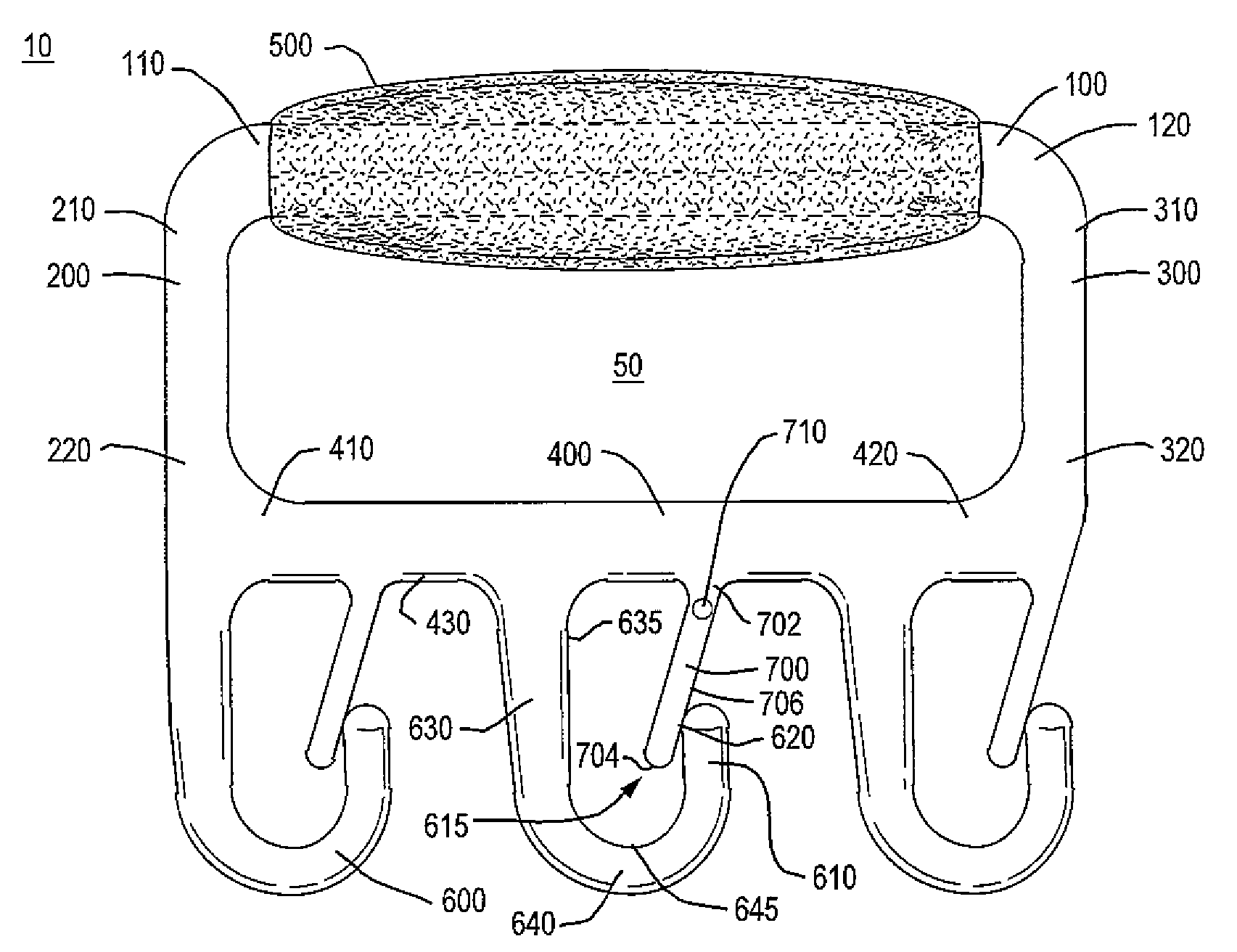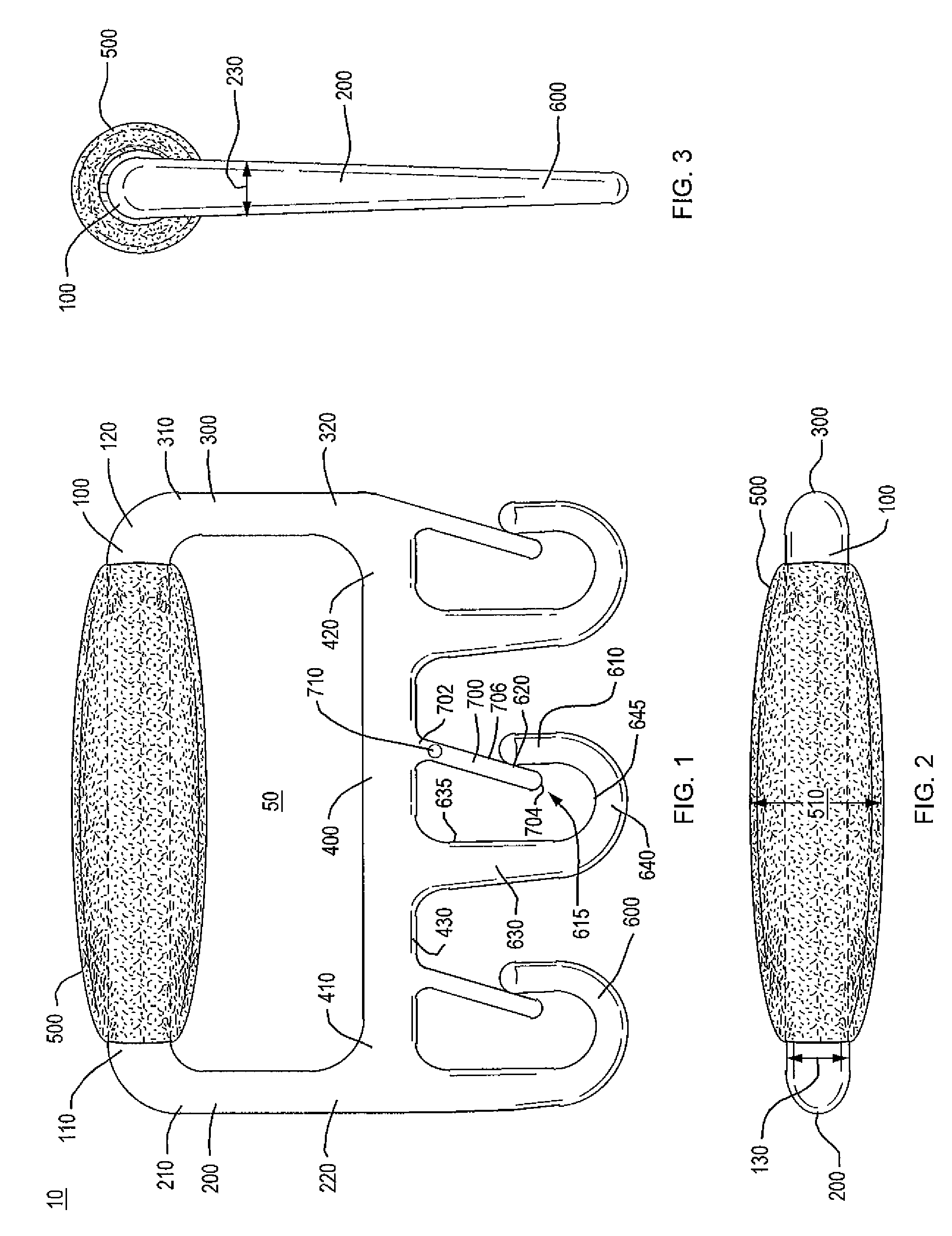Once those products are paid for and placed into several bags, the shopper is left with the unpleasant task of having to transport the bags home.
For those who hate to shop, this bag transporting burden only worsens the shopping experience.
Further, when bags must be carried by an individual for an extended period of time, such as when a person walks home from a supermarket or a shopping mall, the bags quickly become cumbersome to carry.
While these handles have made bag carrying easier, they have not necessarily made bag carrying easy.
One of the primary complaints of those who engage in the common practice of carrying several heavy bags is that the handles of the bags exert great pressure on their hands.
Sometimes this pressure is so substantial that the bags
bruise, or even
cut into, the
skin.
Carrying only a few bags at a time, however, can be an inconvenient practice, especially when doing so means having to make more trips.
Worse, for walkers, this typically means having to make more trips to and from the store.
Bags can be difficult to transport even when they are not being carried by an individual, such as when they are being transported in a vehicle.
In some cases, this leads to eggs being cracked, the top of a
bleach bottle being broken and
bleach being spilled, and to the occurrence of other similarly irritating, if not hazardous, events.
All of these devices, however, are substantially limited in at least two ways.
First, none of these devices has an effective means for keeping bags on their hook or hooks.
Such inadvertent unloading is problematic because a bag that is freed from its hook is more likely to release its items than is a bag that remains secured to its hook.
Furthermore, a bag loaded onto a hook of any of these devices also is prone to being accidentally unloaded from the hook even while the user is carrying the device, such as when the user runs to catch a
bus or gets one or more bags entangled around the end of a stairway railing.
Second, these devices are limited because each of their handles is made of a hard material and is of a relatively narrow design.
Therefore, even when few, or even no, bags are loaded onto one of these devices, the hard, narrow
handle makes the device uncomfortable to grip.
Even worse, the device becomes increasingly more uncomfortable to grip as the weight that it holds is increased.
Some of these devices are further limited because they are incapable of carrying more than a few bags.
Like the devices described above, Finkleman's device also has substantial limitations.
One of the most substantial limitations of the Finkleman device is that it is specifically designed to prevent the bags that it holds from interfering with each other when they are being carried by the user.
A bag carrying device that allows its bags to swing freely is undesirable in many respects, however.
Generally this is true because free swinging bags are more difficult to carry than are bags that are held stationary, or substantially stationary, with respect to the carrying device.
Further, items in a freely swinging bag are more likely to collide inside the bag, and therefore are more likely to become damaged, than are those in a bag that does not swing.
By requiring such free swinging, the Finkleman device therefore frustrates the very goal that the bags are meant to achieve, which is to safely and conveniently hold items.
In addition to being difficult to the problems that are caused by allowing its bags to swinging freely, the Finkleman device is further limited in that each of its hooks is designed to carry only one bag at a time.
Therefore, the Finkleman device is limited to being used to carry only a few bags, which means that individuals having to carry several bags at once either would need to carry two of the Finkleman devices, one for each hand, to fully satisfy their bag carrying needs.
This would be undesirable because it would not leave the user with a free hand for performing tasks that people are prone to do while carrying bags, such as opening a
car door, reaching into a pocket for
bus change, or making a call on a
cell phone.
In cases where two of the Finkleman devices would not be enough, prospective users would be forced to choose between making multiple trips and not using the device altogether.
Another limitation of the Finkleman device is that it is not optimally durable.
This thin, streamlined construction makes the device particularly susceptible to breakage and to unwanted flexing.
When broken, the utility of the device is compromised, if not eliminated altogether.
Another limitation of the Finkleman carrying device is that it is not optimally designed to allow its user to add or remove bags from its clip elements while the device is being held by the user.
This problem is attributed to a few design flaws.
First, the device is relatively large as compared with the frame of an average-sized individual.
Second, the need to accommodate several clip members and to space them such that bags hanging from them do not touch when being carried means that some of the clip members, and particularly the clip members positioned at both extreme ends of the device, are inconveniently too far in front of, or in back of, the individual during normal carrying.
Third, the device, as mentioned before, is thin and flexible.
In combination, these design flaws effectively force an individual carrying bags with the Finkleman device, such as during normal use, to maneuver the device awkwardly in order to access the clip members, and particularly the clip members at the extreme ends of the device.
Specifically, due to the device's relatively
large size, the clip members are not easily reachable when the device is held at arm's length to the individual's side, as an individual would be expected to hold it during normal use.
Further, holding the device by this one end would mean that the other end would be left to dangle away from the individual.
Pronounced dangling of this end would be particularly undesirable where the dangling end holds a bag, namely because the weight of the bag would cause the end of the device having the clip member of interest, and the device itself, to pull away from the individual as he attempts to access that clip member.
This weighted pulling, in conjunction with the increased flexibility of the device, would cause the end being gripped by the user to torque within the user's hand, which, in turn, would cause overall unsteadiness within the device.
However, where the device is being used in certain locales, such as on packed subway cars or while riding on an escalator, for example, it would not be practical, or perhaps even possible, to set the device down.
Yet another limitation of the Finkleman device is that like the devices described above, the grip of its
handle is not optimally designed to provide the user with maximum comfort.
The
hardness of the handle provides its user no
cushion to protect the user's hands against the strain of carrying heavy items.
Further, these grooves may be hazardous to some users.
The Finkleman device is also limited in that it is difficult to keep clean.
Build-up of such materials is unsanitary, and therefore poses a
health hazard, especially where the device is being used to carry bags containing food.
This is particularly troublesome because due to the contours of the grooves, a quick wiping of the device with a cloth and a
cleanser would be insufficient for removing such undesirable deposits of filth.
For this reason, thorough cleaning of the Finkleman device would require extensive time and effort, and perhaps even special cleaning equipment.
For the busy shopper, this would create an undue burden.
 Login to View More
Login to View More  Login to View More
Login to View More 

